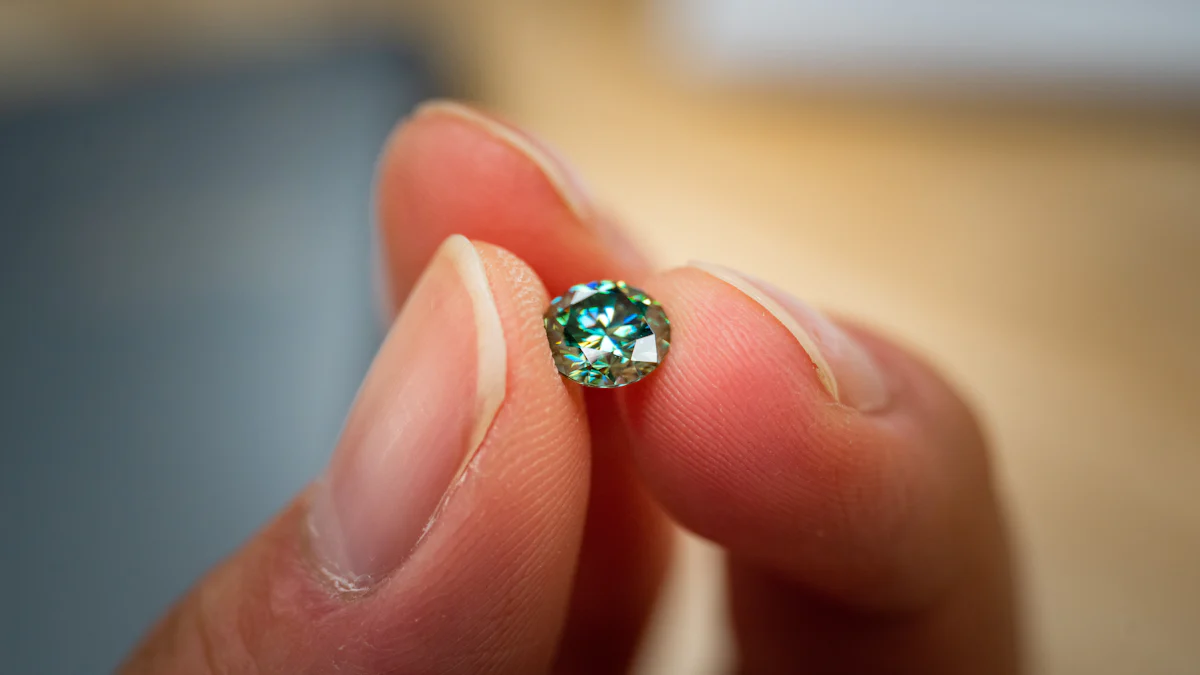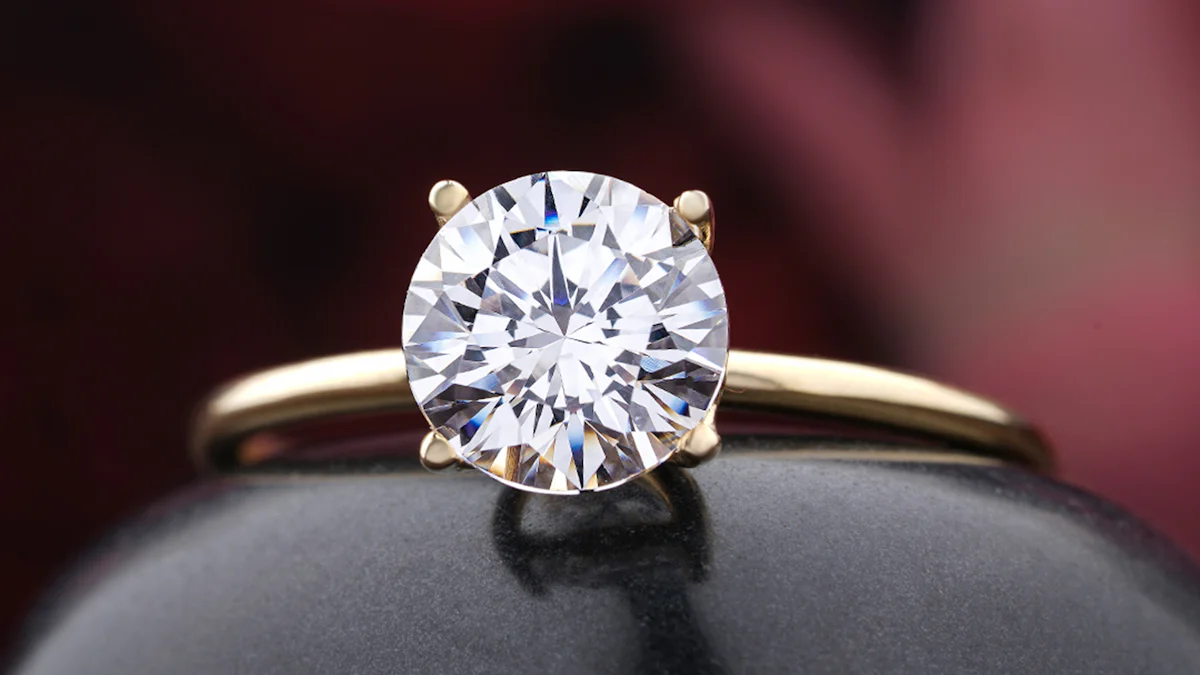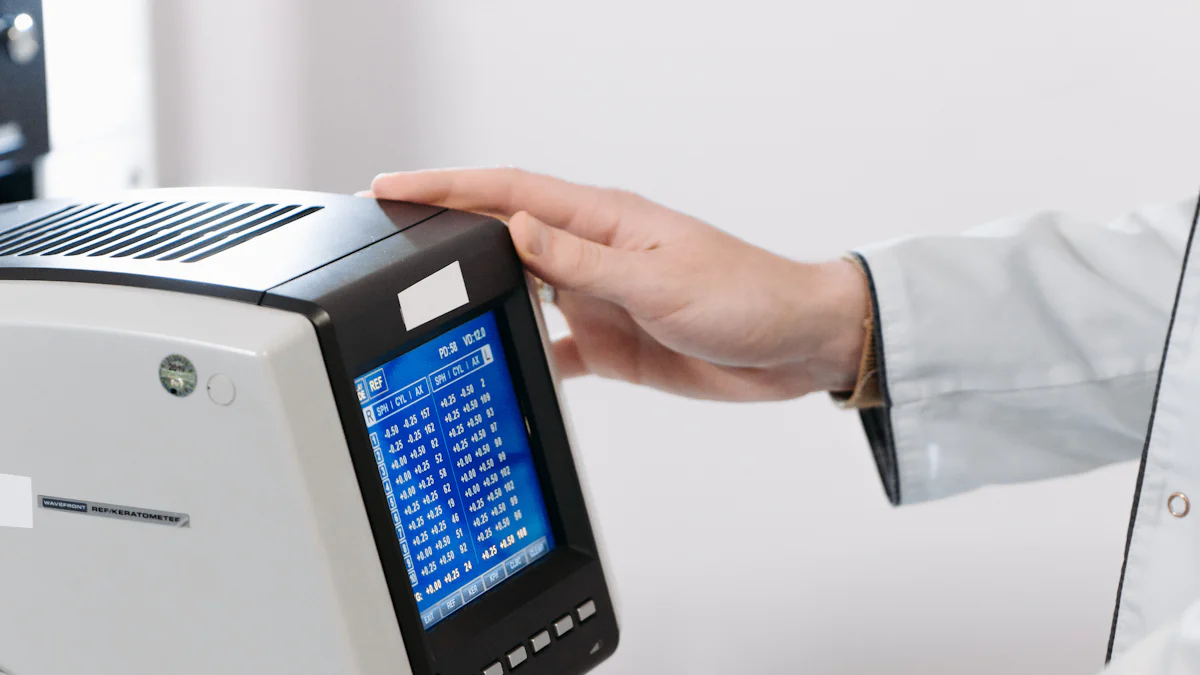Do Moissanite Pass Diamond Tester? Find Out Here

Moissanite often surprises gem enthusiasts because moissanite can pass diamond testers in certain cases. This occurs due to its thermal conductivity being very similar to that of diamonds. Basic testers, particularly those that rely only on heat transfer, may struggle to distinguish between the two. However, advanced diamond testers, which measure both thermal and electrical conductivity, are more effective at providing accurate results. Synthetic moissanite, unlike diamonds, conducts electricity, making electrical conductivity testing a dependable method for identification. Understanding these distinctions helps prevent misidentification and ensures precise gemstone evaluation.
How Do Diamond Testers Work?

Diamond testers are essential tools for identifying gemstones. They analyze specific properties of a stone to determine if it is a genuine diamond or an imitation. These devices rely on advanced technology to measure thermal and electrical conductivity, which are unique characteristics of diamonds. Understanding how these testers work can help you make informed decisions when evaluating gemstones.
Thermal Conductivity Testers
Thermal conductivity testers are among the most common types of diamond testers. They measure how efficiently heat travels through a gemstone. Diamonds are exceptional thermal conductors, meaning they transfer heat much faster than most other stones. When you place the tester's probe on a diamond, the device detects this rapid heat transfer and confirms its authenticity.
However, thermal conductivity testers have limitations. Moissanite, a popular diamond alternative, also conducts heat at a rate similar to diamonds. This similarity can cause these testers to misidentify moissanite as a diamond. While thermal conductivity testers are useful, they may not always provide accurate results when dealing with certain simulants.
Electrical Conductivity Testers
Electrical conductivity testers take gemstone evaluation a step further. These devices measure how well a stone conducts electricity. Diamonds, unlike moissanite, are poor electrical conductors. When you use an electrical conductivity tester, it can distinguish between diamonds and moissanite by detecting this difference.
This method is more reliable for identifying moissanite. If you want to avoid misidentification, consider using a tester that includes electrical conductivity measurements. These testers reduce the chances of errors and provide a clearer distinction between gemstones.
Dual-Mode Diamond Testers
Dual-mode diamond testers combine thermal and electrical conductivity testing in one device. These advanced tools offer a more comprehensive approach to gemstone identification. By analyzing both heat and electricity transfer, they can accurately differentiate between diamonds, moissanite, and other simulants.
For example, the GemOro UltraTester 3 and the Presidium Adamas Diamond & Moissanite Tester are well-known dual-mode testers. These devices are designed to provide precise results, making them ideal for professionals and enthusiasts alike. If you want a reliable tool for gemstone evaluation, investing in a dual-mode tester is a smart choice.
Can Moissanite Pass a Diamond Tester?
Why Moissanite Can Pass Thermal Conductivity Testers
Moissanite often confuses basic diamond testers because of its thermal conductivity. These testers measure how quickly heat moves through a gemstone. Diamonds excel at transferring heat, which is why they register as authentic on these devices. However, synthetic moissanite shares a similar thermal conductivity level. This similarity allows moissanite to pass diamond tester pens that rely solely on heat transfer.
For example, when you test moissanite with a thermal conductivity device, the results may indicate it is a diamond. This happens because the tester cannot differentiate between the two materials based on heat alone. While this method works well for identifying most gemstones, it struggles with moissanite due to its unique properties.
Electrical Conductivity as a More Reliable Method
Electrical conductivity testing provides a more accurate way to distinguish moissanite from diamonds. Unlike diamonds, synthetic moissanite conducts electricity. When you use a diamond tester that measures electrical conductivity, it can detect this difference. This makes it easier to identify moissanite and avoid misidentification.
Advanced diamond testers, such as dual-mode devices, combine thermal and electrical conductivity measurements. These tools analyze both properties to deliver precise results. For instance, a tester like the Presidium Adamas Diamond & Moissanite Tester can reliably identify synthetic moissanite by detecting its electrical conductivity. If you want dependable results, consider using a tester with this capability.
Factors That Affect the Accuracy of Diamond Testers
Several factors influence the accuracy of diamond testers. The quality of the tester plays a significant role. Low-quality devices often produce inconsistent results, especially when testing synthetic moissanite. These testers may fail to detect subtle differences in conductivity, leading to errors.
Environmental conditions also impact the performance of diamond testers. Temperature fluctuations or improper handling can affect the readings. For example, if the tester's probe is not placed correctly on the gemstone, the results may be unreliable. To ensure accuracy, always follow the manufacturer's instructions and maintain the device properly.
Additionally, the type of gemstone being tested matters. Synthetic moissanite, with its unique thermal and electrical properties, challenges basic testers. Using a dual-mode tester or consulting a professional gemologist can help you achieve more reliable results.
Limitations of Diamond Testers for Moissanite Detection
Inconsistent Results with Low-Quality Diamond Testers
Low-quality diamond testers often fail to provide reliable results. These devices lack the precision needed to differentiate between diamonds and synthetic moissanite. For example, some testers may incorrectly identify synthetic moissanite as a diamond due to their inability to measure electrical conductivity accurately. This issue becomes more apparent when testing gemstones with properties similar to diamonds.
Imagine this scenario: A customer tests a family heirloom believed to be a diamond using a basic tester. The device fails to confirm it as a diamond. Even after trying multiple testers, the results remain inconsistent. This situation highlights how unreliable low-quality testers can be, especially when dealing with synthetic moissanite or other diamond alternatives. Investing in a high-quality tester ensures more accurate readings and reduces the chances of misidentification.
Misinterpretation of Tester Results
Misinterpreting the results from diamond testers can lead to confusion. Many testers rely on thermal conductivity alone, which makes it easy to mistake synthetic moissanite for a diamond. Without understanding how these devices work, you might trust inaccurate readings. For instance, if a tester indicates a gemstone is a diamond, you could assume it is genuine without considering the possibility of synthetic moissanite.
To avoid such errors, you need to understand the limitations of these devices. Thermal conductivity testers, while useful, cannot reliably spot moissanite. Dual-mode testers that measure both thermal and electrical conductivity offer better accuracy. By learning how to interpret the results correctly, you can make informed decisions and avoid costly mistakes.
The Need for Additional Testing Methods
Relying solely on diamond testers is not enough to spot moissanite effectively. These devices, even advanced ones, have limitations. Synthetic moissanite shares many properties with diamonds, making it challenging to distinguish between the two using standard testers. To ensure accurate identification, you should consider additional testing methods.
Professional gemstone testing provides a reliable alternative. Gemologists use advanced tools and techniques to analyze gemstones thoroughly. Visual inspection techniques, such as checking for double refraction, can also help spot moissanite. UV light testing is another effective method, as synthetic moissanite often reacts differently under ultraviolet light compared to diamonds. Combining these methods with a high-quality tester increases your chances of accurate identification.
Alternative Methods to Distinguish Moissanite from Diamonds

When diamond testers fall short, alternative methods can help you differentiate between diamonds and moissanite. These techniques provide additional clarity and ensure accurate identification. By using these methods, you can confidently evaluate gemstones without relying solely on a tester.
Visual Inspection Techniques
Visual inspection remains one of the simplest ways to identify synthetic moissanite. Under magnification, you can observe unique optical properties that set it apart from diamonds. For instance, moissanite exhibits double refraction, which means you may see a doubled image of its facets when viewed through a loupe. Diamonds, on the other hand, do not display this characteristic.
Another key difference lies in brilliance and fire. Moissanite often shows more colorful flashes of light compared to diamonds. This heightened fire can make it appear more vibrant under certain lighting conditions. By closely examining these traits, you can begin to differentiate between diamonds and moissanite with greater accuracy.
Expert Insight: "Upon close inspection, a trained jeweler can distinguish between moissanite and diamonds. Moissanite's unique optical properties, such as its refractive index and fire, can help identify it from a diamond." – Gemologists
Professional Gemstone Testing
For a definitive answer, professional gemstone testing offers unmatched reliability. Gemologists use advanced tools and techniques to analyze gemstones thoroughly. They often combine multiple methods, such as spectroscopic analysis and magnification, to identify synthetic moissanite with precision.
A professional gemologist can also use specialized equipment like a moissanite tester. This device measures electrical conductivity, which is a property unique to synthetic moissanite. Unlike diamonds, moissanite conducts electricity, making this test highly effective. Consulting a professional ensures that you receive an accurate evaluation, especially when dealing with high-value gemstones.
Expert Insight: "For a conclusive identification, gemologists often recommend using a combination of tests, including visual inspection under magnification, to observe for differences in brilliance, fire, and facets." – Gemologists
UV Light Testing
UV light testing provides another reliable way to differentiate between diamonds and moissanite. When exposed to ultraviolet light, synthetic moissanite often reacts differently than diamonds. This reaction occurs because UV light affects the gemstone's electrical conductivity. By shining a UV light on the stone, you can enhance the accuracy of a moissanite tester or confirm its identity visually.
This method works well in situations where other tests yield inconclusive results. For example, if a diamond tester struggles to identify a gemstone, UV light testing can provide additional clarity. It is a quick and effective technique that complements other identification methods.
Expert Insight: "Ultraviolet light affects the way a moissanite tester works. Shining a UV light on the moissanite during testing helps the gemstone to be identified correctly." – Gemologists
By combining these alternative methods, you can confidently differentiate between diamonds and moissanite. Whether you rely on visual inspection, professional testing, or UV light, these techniques offer valuable insights into the unique properties of synthetic moissanite.
Moissanite can sometimes pass diamond testers, especially those that rely on thermal conductivity. This happens because synthetic moissanite shares similar heat transfer properties with diamonds. However, advanced diamond testers, which measure both thermal and electrical conductivity, provide more reliable results. These tools can accurately identify synthetic moissanite by detecting its unique electrical conductivity. For precise identification, you should also consider alternative methods like visual inspection or professional gemstone testing. Investing in a high-quality tester and understanding its limitations ensures you can confidently distinguish between moissanite and diamonds.
FAQ
Can moissanite pass a diamond tester?
Yes, moissanite can pass certain diamond testers, especially those that rely on thermal conductivity. These testers measure how efficiently heat transfers through a gemstone. Since moissanite shares similar thermal properties with diamonds, it often registers as a diamond on these devices. However, advanced testers that also measure electrical conductivity can distinguish between the two.
Tip: To ensure accurate identification, consider using a dual-mode tester or consulting a professional gemologist.
Why do some diamond testers fail to detect moissanite?
Some diamond testers only measure thermal conductivity, which is not enough to differentiate moissanite from diamonds. Moissanite conducts heat almost as efficiently as diamonds, leading to false positives. Low-quality testers or improper use, such as incorrect probe placement, can also result in inaccurate readings.
Expert Insight: "A reliable diamond tester should combine thermal and electrical conductivity measurements to avoid misidentification."
Can moissanite be mistaken for a diamond by the untrained eye?
Yes, moissanite can easily be mistaken for a diamond due to its similar appearance. Both gemstones exhibit brilliance and sparkle, but moissanite often displays more colorful flashes of light. Without proper tools or training, most people cannot tell the difference.
Did You Know? Moissanite exhibits double refraction, a property that can help you identify it under magnification.
What is a moissanite tester, and how does it work?
A moissanite tester is a specialized device designed to identify moissanite by measuring its electrical conductivity. Unlike diamonds, moissanite conducts electricity, making this test highly effective. These testers are particularly useful when a diamond tester cannot provide a definitive result.
Pro Tip: If you already own a diamond tester, consider adding a moissanite tester to your toolkit for more accurate evaluations.
Are all diamond testers reliable for identifying moissanite?
No, not all diamond testers are reliable for identifying moissanite. Basic testers that only measure thermal conductivity often fail to differentiate between the two. High-quality dual-mode testers, which analyze both thermal and electrical properties, offer more accurate results.
Recommendation: Devices like the Presidium Adamas Diamond & Moissanite Tester are known for their precision in distinguishing between diamonds and moissanite.
How can I ensure my gemstone is accurately identified?
To ensure accurate identification, use a combination of methods. Start with a high-quality dual-mode diamond tester. Follow up with visual inspection techniques, such as checking for double refraction. For a definitive answer, consult a professional gemologist who can use advanced tools and techniques.
Key Takeaway: Certification from a trusted gemological lab guarantees the authenticity of your gemstone.
Does moissanite have the same value as a diamond?
No, moissanite does not hold the same value as a diamond. While it is a stunning and durable gemstone, moissanite is more affordable due to its synthetic origin. Diamonds, whether natural or lab-grown, typically have higher market value.
Fun Fact: Many people choose moissanite for its brilliance and cost-effectiveness, making it a popular alternative to diamonds.
Can UV light testing help identify moissanite?
Yes, UV light testing can help differentiate moissanite from diamonds. When exposed to ultraviolet light, moissanite often reacts differently due to its unique properties. This method works well as a supplementary test when other methods yield inconclusive results.
Expert Advice: "Shining UV light on moissanite can enhance the accuracy of identification, especially when combined with other tests."
Is it possible to mistake lab-grown diamonds for moissanite?
Yes, some diamond testers may incorrectly identify lab-grown diamonds as moissanite. This happens because lab-grown diamonds and moissanite share similar thermal conductivity. Advanced testers that measure both thermal and electrical properties can help avoid this confusion.
Important Note: Always verify lab-grown diamonds with professional testing or certification to ensure accurate identification.
Should I invest in a dual-mode diamond tester?
If you frequently evaluate gemstones, investing in a dual-mode diamond tester is a smart choice. These devices combine thermal and electrical conductivity testing, providing more reliable results. They are especially useful for distinguishing between diamonds, moissanite, and other simulants.
Top Picks: Consider models like the GemOro UltraTester 3 or the Presidium Adamas Diamond & Moissanite Tester for professional-grade accuracy.
See Also
Tips for Spotting Authentic Diamond Rings at Home
Is the 1.6 ct Diamond Ring Really Worth It?
Comprehensive Review of 5 Carat Lab Grown Tennis Bracelet

